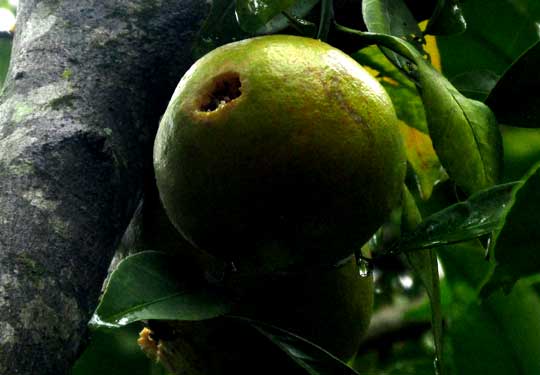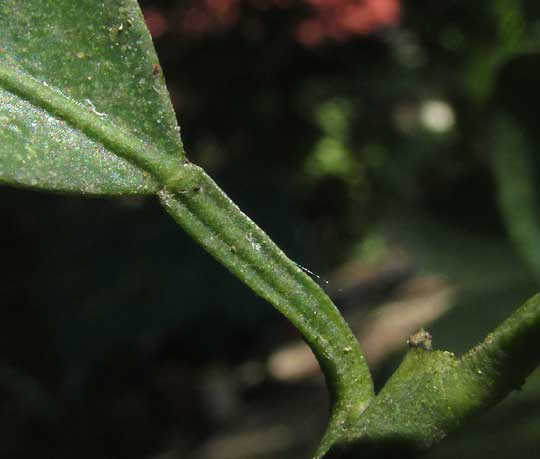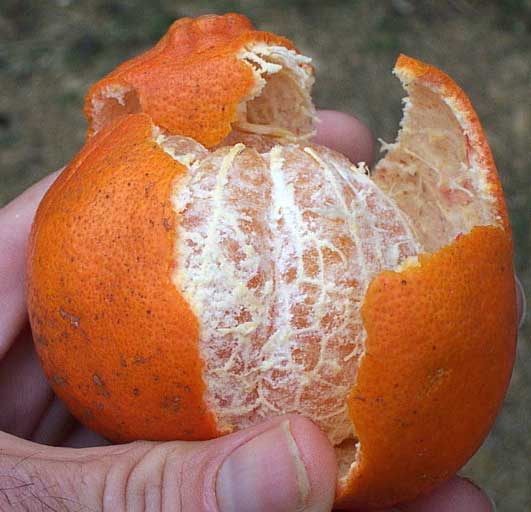Excerpts from Jim Conrad's
Naturalist Newsletter

from the December 13, 2015 Newsletter issued from Hacienda Chichen Resort beside Chichén Itzá Ruins, central Yucatán, MÉXICO
"MAYA" TANGERINES
Quotation marks surround "Maya" because officially there's no such thing as a Maya Tangerine. I'm calling what we have here that, though, because our local tangerines -- ones planted in people's yards -- are different from others I've seen, in that their fruits are smaller, greenish and relatively seedy. I'm figuring that our trees -- at least the one near my hut -- are descendants of ancestors brought here long ago, before modern tangerine cultivars were developed.
First, below, in the next section, take a look at a tangerine we plucked from a tree in Querétaro, north-central Mexico, back in 2007.
I think that that fruit is more or less what is sold in markets up north, though maybe the northern ones have thicker skins so that they ship better. Now, atop this page, look at the smaller, greener, thinner-skinned fruit we have here, one whose juicy parts are coated with much less white, pulpy material (the mesocarp), whose skin comes loose much less easily, and which is much less sweet -- in fact fairly sour -- compared to the Querétaro one and those in northern supermarkets:
Our local tangerine fruits become orange only when lying on the ground bug-eaten, bird-pecked and rotting. Below, you can see a green one that would be ready for picking if it hadn't been spoiled by the resident Golden Fronted Woodpecker:

When a citrus tree bears tangerines it's obviously a tangerine tree, but most of the year when no fruits are in sight, it can be hard to distinguish a tangerine tree from other non-fruit-bearing citrus trees, such as orange, lemon, lime and grapefruit trees. Hard, that is, unless you pay close attention to the leaves' size and the condition of their petioles. You can see our tangerine tree's leaves below:

Tangerine leaves are smaller than other common citrus types. They're about 1½ inch long (4cm) as opposed to lime leaves that are about 2½ inches(6.5cm), and orange leaves, which over twice their length, and grapefruit leaves, which can be up to five times as long. Also, notice that the leaves' stalks, or petioles, are jointed at their attachment with their blades. A closer look at an "articulated petiole" is shown below:

Citron petioles aren't jointed like that, but the other commonly known citrus leaves are. Also, notice that the petioles are "winged" with thin ridges along their sides. In some citrus species the wings are much expanded, as on the Sour Orange we looked at here in 2011, shown at www.backyardnature.net/n/11/111127nk.jpg.
Among the citrus species, tangerine leaves are noted for their smallness, and their narrowly winged petioles.
In everyday English, a tangerine fruit is simply a small, orange-like fruit whose skin comes off easily and whose interior parts separate without much trouble. However, in taxonomy, the lines between tangerine plants and their cousins aren't at all clear. You might enjoy looking at a page entitled "What's the Difference between Tangerines, Clementines, and Mandarins?"
Nowadays some specialists maintain that the Tangerine plant constitutes an independent species called Citrus tangerina. However, others think it's a hybrid between two stand-alone species, and still others, maybe the majority, regard it as a variety of the Mandarin Orange, in which case its name would be CITRUS RETICULATA.
Whatever its taxonomic affiliation, this season I've enjoyed my share of fruits from the tangerine tree near my hut, often adding their acidy little sections to my morning oatmeal. And I'm glad to show our "Maya Tangerines" to the world, because they may be a long forgotten ancestor of today's mass-produced market tangerines. As such, our Maya Tangerines' genes, evolved in the context of the tropics' many diseases, someday may be much sought after, when plague ravages the vast monocultures of cultivars producing super-sweet, super-orange-colored, super-easy-to-break-apart fruits so popular in markets nowadays.
from the January 26, 2007 Newsletter issued from Jalpan, Sierra Gorda Biosphere Reserve, Querétaro, MÉXICO Sunkist's online Tangerine Page says that there are three major tangerine types: tangerines; mandarins, and; tangelos. Then each of these types has different varieties, such as the Fairchild and Dancy. I'm not sure which variety ours is. They're deep, almost reddish orange and with just one thumbnail scratch across a fruit's top the peel comes loose. I've never seen tangerines with such loose-fitting skin, and a whole fruit contains only two or three soft seeds. Sometimes I eat the peel itself. It's like wanting to experience even the dark side of a beautiful woman: Maybe it's a need to complement the sweetness with bitterness, if only to attain esthetic balance. It's sad to see fruits rotting on trees, and white fungus-pustules appearing on otherwise perfect fruits heaped in marketplace bins. But, every season passes and something else comes along. Oranges are still at their peak. The next thing to look forward to, I'm told, is mango season in April. If you know the tangerine varieties maybe you can tell me what kind we have. A picture of one in my hand is at the page top.
TANGERINES
